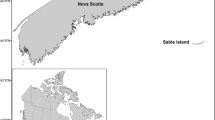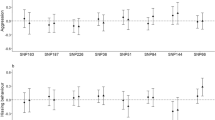Abstract
Recent studies indicate that polymorphisms of the DRD4 gene may be related to behavioural variation in mammals and birds. The purpose of this study was to ascertain a connection between DRD4 genotypes and behavioural patterns in a wild passerine bird during breeding time. We evaluated changes in birds’ parental provisioning behaviour in the presence of a novel object. As a behavioural trait, we measured the duration of feeding interruption from the first time that each bird noticed the novel object until they entered the nest box. We found a gender-specific association between DRD4 gene polymorphism and parental behaviour. Males with a CC genotype delayed feeding for a longer period than those with CT and TT genotypes. No significant effect of genotype on provisioning behaviour was observed among females. We conclude that (i) DRD4 gene polymorphism in wild birds can be associated with behaviour related to fearfulness, and (ii) this effect is supposedly gender-specific during the breeding time, potentially explained by sex differences in parental care or hormonal levels.



Similar content being viewed by others
References
Abe H, Takeuchi H, Yamada S, Nakamura A, Nagao K, Nirasawa K, Ito S, Inoue-Murayama M (2013) Characterization of the intronic VNTR polymorphisms found in a paralog of chicken serotonin transporter gene. Anim Sci J 84:281–288
Becker K, Laucht M, El-Faddagh M, Schmidt M (2005) The dopamine D4 receptor gene exon III polymorphism is associated with novelty seeking in 15-year-old males from a high-risk community sample. J Neural Transm 112:847–858
Chamary J, Parmley JL, Hurst LD (2006) Hearing silence: non-neutral evolution at synonymous sites in mammals. Nat Rev Genet 7:98–108
Clark AS, Henderson LP (2003) Behavioral and physiological responses to anabolic-androgenic steroids. Neurosci Biobehav R 27:413–436
Cole EF, Quinn JL (2014) Shy birds play it safe: personality in captivity predicts risk responsiveness during reproduction in the wild. Biol Lett 10:20140178
Dmitrieva J, Chen C, Greenberger E, Ogunseitan O, Ding Y-C (2011) Gender-specific expression of the DRD4 gene on adolescent delinquency, anger and thrill seeking. Soc Cogn Affect Neur 6:82–89
Duan J, Wainwright MS, Comeron JM, Saitou N, Sanders AR, Gelernter J, Gejman PV (2003) Synonymous mutations in the human dopamine receptor D2 (DRD2) affect mRNA stability and synthesis of the receptor. Hum Mol Genet 12:205–216
Ebstein R (2006) The molecular genetic architecture of human personality: beyond self-report questionnaires. Mol Psychiatr 11:427–445
Ebstein RP, Benjamin J, Belmaker RH (2000) Genetics of personality dimensions. Curr Opin Psychiatr 13:617–622
El-Faddagh M, Laucht M, Maras A, Vöhringer L, Schmidt M (2004) Association of dopamine D4 receptor (DRD4) gene with attention-deficit/hyperactivity disorder (ADHD) in a high-risk community sample: a longitudinal study from birth to 11 years of age. J Neural Transm 111:883–889
Fidler AE, van Oers K, Drent PJ, Kuhn S, Mueller JC, Kempenaers B (2007) Drd4 gene polymorphisms are associated with personality variation in a passerine bird. Proc Biol Sci 274:1685–1691
Flisikowski K, Schwarzenbacher H, Wysocki M, Weigend S, Preisinger R, Kjaer JB, Fries R (2009) Variation in neighbouring genes of the dopaminergic and serotonergic systems affects feather pecking behaviour of laying hens. Anim Genet 40:192–199
Garamszegi LZ, Mueller JC, Markó G, Szász E, Zsebők S, Herczeg G, Eens M, Török J (2014) The relationship between DRD4 polymorphisms and phenotypic correlations of behaviors in the collared flycatcher. Ecol Evol 4:1466–1479
Grady DL, Thanos PK, Corrada MM et al (2013) DRD4 genotype predicts longevity in mouse and human. J Neurosci 33:286–291
Hejjas K, Kubinyi E, Ronai Z, Szekely A, Vas J, Miklosi A, Sasvari-Szekely M, Kereszturi E (2009) Molecular and behavioral analysis of the intron 2 repeat polymorphism in the canine dopamine D4 receptor gene. Genes Brain Behav 8:330–336
Hong KW, Inoue-Murayama M, Nakamura A, Nago K (2008) Characterization of two microsatellites in chicken monoamine oxidase A. Anim Sci J 79:641–643
Inoue-Murayama M (2009) Genetic polymorphism as a background of animal behavior. Anim Sci 80:113–120
Kang JI, Namkoong K, Kim SJ (2008) Association of DRD4 and COMT polymorphisms with anger and forgiveness traits in healthy volunteers. Neurosci Lett 430:252–257
Kluen E, Kuhn S, Kempenaers B, Brommer JE (2012) A simple cage test captures intrinsic differences in aspects of personality across individuals in a passerine bird. Anim Behav 84:279–287
Kluger A, Siegfried Z, Ebstein R (2002) A meta-analysis of the association between DRD4 polymorphism and novelty seeking. Mol Psychiatr 7:712–717
Korsten P, Mueller JC, Hermannstädter C et al (2010) Association between DRD4 gene polymorphism and personality variation in great tits: a test across four wild populations. Mol Ecol 19:832–843
Laucht M, El-Faddagh M, Hohm E, Schmidt MH (2005) Association of the DRD4 exon III polymorphism with smoking in fifteen-year-olds: a mediating role for novelty seeking? J Am Acad Child Adolesc Psychiatry 44:477–484
Missale C, Nash SR, Robinson SW, Jaber M, Caron MG (1998) Dopamine receptors: from structure to function. Physiol Rev 78:189–225
Momozawa Y, Takeuchi Y, Kusunose R, Kikusui T, Mori Y (2005) Association between equine temperament and polymorphisms in dopamine D4 receptor gene. Mamm Genome 16:538–544
Mueller J, Edelaar P, Carrete M, Serrano D, Potti J, Blas J, Dingemanse N, Kempenaers B, Tella J (2014) Behaviour-related DRD4 polymorphisms in invasive bird populations. Mol Ecol 23:2876–2885
Mueller JC, Korsten P, Hermannstädter C et al (2013) Haplotype structure, adaptive history and associations with exploratory behaviour of the DRD4 gene region in four great tit (Parus major) populations. Mol Ecol 22:2797–2809
Mänd R, Tilgar V, Lohmus A, Leivits A (2005) Providing nest boxes for hole-nesting birds - Does habitat matter? Biodivers Conserv 14:1823–1840
O’Hara RB, Kotze DJ (2010) Do not log-transform count data. Methods Ecol Evol 1:118–122
Nakagawa S, Cuthill IC (2007) Effect size, confidence interval and statistical significance: a practical guide for biologists. Biol Rev 82:591–605
Queller DC (1997) Why do females care more than males? Proc R Soc Lond B 264:1555–1557
Réale D, Reader SM, Sol D, McDougall PT, Dingemanse NJ (2007) Integrating animal temperament within ecology and evolution. Biol Rev 82:291–318
Reif A, Lesch KP (2003) Toward a molecular architecture of personality. Behav Brain Res 139:1–20
Richter SH, Garner JP, Würbel H (2009) Environmental standardization: cure or cause of poor reproducibility in animal experiments? Nat Methods 6:257–261
Schinka J, Letsch E, Crawford F (2002) DRD4 and novelty seeking: results of meta-analyses. Am J Med Genet 114:643–648
Sih A, Bell A, Johnson JC (2004) Behavioral syndromes: an ecological and evolutionary overview. Trends Ecol Evol 19:372–378
Stuber EF, Araya-Ajoy YG, Mathot KJ, Mutzel A, Nicolaus M, Wijmenga JJ, Mueller JC, Dingemanse NJ (2013) Slow explorers take less risk: a problem of sampling bias in ecological studies. Behav Ecol 24:1092–1098
van Oers K, de Jong G, van Noordwijk AJ, Kempenaers B, Drent PJ (2005) Contribution of genetics to the study of animal personalities: a review of case studies. Behaviour 142:9–10
van Oers K, Drent PJ, de Goede P, van Noordwijk AJ (2004a) Realized heritability and repeatability of risk-taking behaviour in relation to avian personalities. Proc R Soc Lond B 271:65–73
van Oers K, Drent PJ, de Jong G, van Noordwijk AJ (2004b) Additive and nonadditive genetic variation in avian personality traits. Heredity 93:496–503
van Oers K, Mueller JC (2010) Evolutionary genomics of animal personality. Philos T Roy Soc B 365:3991–4000
Wan M, Hejjas K, Ronai Z, Elek Z, Sasvari-Szekely M, Champagne FA, Miklosi A, Kubinyi E (2013) DRD4 and TH gene polymorphisms are associated with activity, impulsivity and inattention in Siberian Husky dogs. Anim Genet 44:717–727
Westneat DF, Hatch MI, Wetzel DP, Ensminger AL (2011) Individual variation in parental care reaction norms: integration of personality and plasticity. Am Nat 178:652–667
Venables WN, Ripley BD (2002) Modern applied statistics with S, 4th edn. Springer, New York
Vrublevska J, Krama T, Rantala MJ, Mierauskas P, Freeberg TM, Krams IA (2014) Personality and density affect nest defence and nest survival in the great tit. Acta Ethol 17:1–10
Acknowledgments
The authors thank Kaarin Koosa for help with fieldwork, Jaanis Lodjak for help with data analysis, and Raivo Mänd and anonymous reviewers for their constructive comments. This study was financed by an Estonian Science Fund grant ETF8376 from the Ministry of Science and Education Target-Financing project no. 01800004 s09, the European Regional Development Fund (Centre of Excellence FIBIR) and from an Institutional Research grant no. IUT 34-8.
Ethical standards
The experiments comply with the current laws of Estonia, specified in text.
Author information
Authors and Affiliations
Corresponding author
Additional information
Communicated by J. A. Graves
Rights and permissions
About this article
Cite this article
Timm, K., Tilgar, V. & Saag, P. DRD4 gene polymorphism in great tits: gender-specific association with behavioural variation in the wild. Behav Ecol Sociobiol 69, 729–735 (2015). https://doi.org/10.1007/s00265-015-1887-z
Received:
Revised:
Accepted:
Published:
Issue Date:
DOI: https://doi.org/10.1007/s00265-015-1887-z




